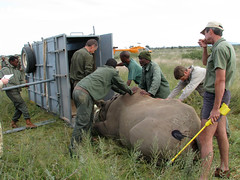Rhino Conservation Medicine Program – Namibia Update
By: Robin W. Radcliffe, DVM, DACZM
To see more of Robin’s photos, visit our Flickr page.
The rainy season in Namibia this year has left a spectacular scene in this wild place. Namibia is a land of remote deserts, but this year it is full of unexpected water. Our local hosts, the Namibian Ministry of Environment and Tourism, tell us that the rains this year are the best they have experienced since 1976. Our adventure begins in Etosha National Park. It is green and lush and teaming with wild animals. Great herds of giraffe, zebra, wildebeest, springbok and zebra abound. We even see a pride of hunting lions. We are here to work in a country holding the second largest population of black rhinoceros left on earth: the desert-adapted black rhinoceros, Diceros bicornis bicornis.
In just 10 days our capture team has examined 29 black rhinoceros. Eighteen of these were immobilized in Etosha for an ear-notching program to identify the rhinos. In close collaboration with African rhinoceros expert Pete Morkel, Namibian capture veterinarian Mark Jago and Namibian rhino coordinator Pierre du Preez, we collaborate on studies in anesthesia to help learn more about the safe capture and translocation of the black rhinoceros of Namibia. We are also training the veterinary team in the application of ultrasound as part of the capture process to help diagnose pregnancy in rhinos at the time of immobilization. With possible concerns over translocation of late pregnant rhinos, we help the team assess pregnancy status including estimates of fetal age to help make informed decisions about whether or not to move a rhino. The ultrasound work began years before at a wildlife reserve in Texas where Fossil Rim staff pioneered the techniques adapted here.
Early each morning Franz takes the spotter plane up to begin his aerial search for black rhinos. Franz is soon joined by helicopter pilot, Jhanne, together with Pete and Mark. The ground team speeds along on dusty roads trying to keep up. The entire team is coordinated by Pierre and we all have radios to allow each part of the team to work together as a group. The ground team arrives at a recumbent rhino minutes after the helicopter and our work begins. Using ultrasound equipment, I show Mark how to examine the female for pregnancy as the rest of our team monitors anesthesia. With me are two colleagues from Cornell University: Robin Gleed is a specialist in equine anesthesia and Julia Flaminio is a professor of equine medicine. Together we are working with our Namibian colleagues to learn more about these amazing rhinos of the desert. We are exploring new techniques in loading rhinoceros for translocation. In one day we captured an amazing 6 rhinoceros!
Rhinoceros immobilized and examined to date:
29 black rhinoceros (Diceros bicornis bicornis)
To see more of Robin’s photos, visit our Flickr page.
The Rhino Conservation Medicine Program, a unique collaboration between the International Rhino Foundation, Fossil Rim Wildlife Center, and the Cornell University College of Veterinary Medicine, provides high-level veterinary medical support for global rhino conservation efforts both in the wild and in captivity.
IRF needs your help to continue providing veterinary support for rhino conservation efforts around the world. Visit our donate page to learn more about how you can help us protect rhinos.



3 thoughts on “Rhino Conservation Medicine Program – Namibia Update”
A very good daredevil effort to capture 6 of them in one day, i am sure you will break this record also.
Well done guys. Save the Rhino Trust has wide acclaim for the excellent conservation projects undertaken, resulting in a remarkable building up of the Rhino population in Namibia – so successfully that I see a tophy hunting quota has been put out. Personally,I must admit it disturbed me – but then again I suppose there needs to be an ecological balance? Keep up the good work. There are many people out there who truly appreciate your efforts.
Just got back from an overnight stay at the Addo Elephant National Park, where I was privaleged, and most fortunate to see 5 of the 35 they have in the wild there. Ive been in South Africa now, 26years,(35 yrs of age) and the park is a mere 30minutes drive away…I stay in Uitenhage, Eastern Cape of SA)
Because the sightings were at night, near a floodlight waterhole, I was unable to take a photo of them…(even with either high ISO settings, extended shutter speeds etc). The 5 consited of 2 sightings of a mother and calf in tow, and a bull, which was tentative to come down to the water hole to drink, as the prescence of a large bull elephant obviously intimidated him.
One thing I would like to point out, is that the black rhino, or at least the subspecies here are extreely timid beasts. yes they have a reputation for charging, and a bad temper, yet, when they are unaware of humans, they still excercise extreme caution, and its nothing like you see on documentaries.
In the last year alone, I have made over 20 trips to this park, and never spotted a black rhino there. The vegetation here is predominantly thicket, with few acaia savanna land which typifies the average african docuentary.
Ive heard that to see one, can be compared to seeing a ghost – quite rare, and nobody belives you.
Its heartbreaking to know that a creature, as robust, as caring, and as magnificent as this, and so frustratingly elusive (hehehe)will one day become like the sightings – A ghost..
Whats further disturbing, is that its not just the Black Rhino, but it’s Asia cousins too.
Its an uphill battle we are facing to maintain, and an even steeper battle to grow the populations of these pachyderms.
You guys are epitomising steely and dogged determination born out of heartfelt love for the dwingling beauty surrounding us.
Nick. G.